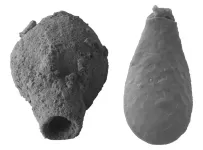(Press-News.org) About 800 million years ago (mya), before the supercontinent Pangea formed, the Earth was more diverse than classical theory suggests. By reconstructing the tree of life from the evolutionary history of amoebas and the ancestors of algae, fungi, plants and animals, Brazilian researchers have created a scenario in which several different lineages of many species inhabited the planet during the period. An article reporting their findings is published in Proceedings of the National Academy of Sciences of the United States of America (PNAS).
According to the literature, several lineages of eukaryotes that first emerged 1.5 billion years ago diversified and established themselves during the Neoproterozoic oxygenation event (850-540 mya), when oxygen levels in the atmosphere and oceans rose significantly owing to changes in the planet’s geochemistry.
Eukaryotes are organisms consisting of one or more cells in which the DNA is contained within a distinct nucleus (all life on Earth except bacteria and archaea).
The study conducted by the researchers focused on the origin and divergence times of amoebozoans, showing that many of these organisms, as well as ancestors of plants, algae, fungi and animals, survived even the two glaciations of the Cryogenian period (790-635 mya, the middle Neoproterozoic Era, preceded by the Tonian and followed by the Ediacaran). According to the snowball earth hypothesis, polar ice extended to cover the entire planet for some 100 million years during this period.
“The classical paradigm for the Neoproterozoic was that there was practically no life on the planet apart from one or two species of bacteria and protists. In the last 15 years, however, fossils of unicellular, eukaryotic and heterotrophic organisms have been identified at various different locations around the world. These fossils date from about 800 mya [and are termed Tonian]. All this joined our study, which reconstituted the tree of life and used maximum likelihood estimation to identify several well-established Tonian lineages of ancestors of amoebae, animals, fungi and plants. This radically changes the paradigm for the manner in which the diversification of life occurred on our planet,” Daniel Lahr, last author of the article and a professor at the University of São Paulo’s Institute of Biosciences (IB-USP), told Agência FAPESP.
In other words, the study dates the mass diversification of life on Earth to some 260 million years earlier than the paradigm, well before the Cambrian explosion (the emergence of new multicellular organisms at the beginning of the Cambrian period between 541 and 530 mya). During this period, the Earth was inhabited mostly by marine invertebrates such as trilobites, brachiopods and graptolites, and had a warm and humid climate with no evidence of glaciers.
“The eukaryotes remained highly diverse despite all the climate changes that occurred during the Neoproterozoic, displaying greater adaptability than expected. This is important because our reconstitution of the phylogenetic tree also serves as a basis for paleoclimate reconstruction research,” Lahr explained.
“A curious aspect is that Arcellinid amoebae then lived in saltwater, whereas now they all live in freshwater. This kind of change is frequently observed in the course of evolution since time began, but it happened to all lineages in the case of these amoebae, showing once again how adaptable these organisms were.”
The researchers deployed innovative techniques to reconstitute the phylogenetic (evolutionary) tree of the genus Thecamoeba, which belongs to the order Arcellinida, and on this basis to rebuild the tree of life, starting with the prime ancestors of plants, fungi, algae and animals.
“The thecamoebians were the foundation for this reconstitution. From there on up, we were able to visualize other organisms that preceded other groups and must also have been present and diversified in the period in question some 800 mya,” Lahr said.
Previous research had revealed eight new ancestral lineages of Thecamoebae, the largest group in Amoebozoa, a clade (a common ancestor and all its descendants) of protozoans with pseudopodia shaped like tubes or flat lobes and used for locomotion and feeding. Thecamoebians are known as testate amoebae because of their hard carapace (read more at: agencia.fapesp.br/29917).
“With the aid of mathematical probability modeling, we were able to determine the morphology of ancestral thecamoebians [from genetic data for species now alive on Earth] and compare it with the fossil morphology. In this study we identified ancestral thecamoebian lineages and the augmented diversification of these organisms in the Neoproterozoic,” Lahr said.
In the study described in PNAS, the scientists advanced their understanding of life on the planet 800 mya by using these thecamoebian lineages as points in calibrating the phylogenetic tree for plants, algae, fungi, animals and their ancestors. FAPESP supported the work via a regular research grant and a PhD scholarship.
“In developing this extension of the tree of life, we made some interesting discoveries about a period in the planet’s history that has always been obscure. By calibrating the tree in accordance with the phylogenetic study of Thecamoebae, we were able to double the amount of information about eukaryotes in the Neoproterozoic. Our analysis of the data showed that a great diversity of lineages began to emerge in the period, one of which was animals and another fungi, possibly alongside plants,” Lahr said.
One of the innovative techniques used in the study, he explained, was single-cell transcriptomics, whereby the entire transcriptome of a single cell or unicellular organism can be sequenced. The transcriptome is the set of all RNA transcripts, including coding and non-coding, in an individual or a population of cells. Transcription, the first step in gene expression, involves copying a gene’s DNA sequence to make an RNA molecule. Transcriptome sequencing enables researchers to trace the evolutionary process in reverse, identifying species that lived in the past.
“Before this technique was invented, it was possible to obtain only transcriptomes of single-cell organisms living in culture, meaning less than 1% of the full diversity of microorganisms. Thanks to this innovation, we were able to structure the phylogeny of Thecamoebae as a whole. It’s a highly diverse group and is interesting because it illuminates these periods in Earth’s history that have fossil records with which we can make comparisons. Aside from this, in the tree of life the amoebae are closer to the animals than to the plants, and this discovery enabled us to make important calibrations,” Lahr said.
About São Paulo Research Foundation (FAPESP)
The São Paulo Research Foundation (FAPESP) is a public institution with the mission of supporting scientific research in all fields of knowledge by awarding scholarships, fellowships and grants to investigators linked with higher education and research institutions in the State of São Paulo, Brazil. FAPESP is aware that the very best research can only be done by working with the best researchers internationally. Therefore, it has established partnerships with funding agencies, higher education, private companies, and research organizations in other countries known for the quality of their research and has been encouraging scientists funded by its grants to further develop their international collaboration. You can learn more about FAPESP at www.fapesp.br/en and visit FAPESP news agency at www.agencia.fapesp.br/en to keep updated with the latest scientific breakthroughs FAPESP helps achieve through its many programs, awards and research centers. You may also subscribe to FAPESP news agency at http://agencia.fapesp.br/subscribe.
END
Life on Earth was more diverse than classical theory suggests 800 million years ago, a Brazilian study shows
According to an article published in the journal PNAS, different lineages of amoebae and ancestors of plants, algae and animals were already established in the Neoproterozoic period and survived the two glaciations that covered the entire planet.
2024-10-04
ELSE PRESS RELEASES FROM THIS DATE:
International clean energy initiative launches global biomass resource assessment
2024-10-04
A multi-country, government-led initiative dedicated to advancing the global transition to a sustainable, bio-based economy, unveiled a new Global Biomass Resource Assessment, providing groundbreaking data on current and future sustainable biomass supplies around the world.
The results from this new global sustainable supply assessment will allow scientists, policymakers, and industry leaders to explore potential sources of biomass as a foundation for a circular and sustainable global bioeconomy, supporting ...
How much do avoidable deaths impact the economy?
2024-10-04
Two new papers in Nature Medicine by a global research team highlight the economic value of reducing avoidable deaths.
The first paper "applies novel methods to estimate the economic value of reducing avoidable deaths worldwide, finding that in 2019, 40 million deaths were avoidable—i.e., could have been prevented or delayed if individuals in all countries had access to the best available healthcare. The economic value of reducing these avoidable deaths is equivalent to 23% of annual global income, suggesting that ...
Federal government may be paying twice for care of veterans enrolled in Medicare Advantage plans
2024-10-04
PROVIDENCE, R.I. [Brown University] — From 2011 to 2020, the Veterans Health Administration spent $78 billion to care for U.S. military veterans enrolled in Medicare Advantage plans, raising questions about federal overpayments to those private plans.
That’s according to an analysis by researchers from Brown University and the Providence Veterans Affairs Medical Center. Published in JAMA, the study notes that because Medicare Advantage plans receive fixed per-patient payments for health care services without having payments reduced when veterans receive care ...
New therapeutic target for cardiac arrhythmias emerges
2024-10-04
A new study by researchers at the University of Arizona College of Medicine – Phoenix and the University of California Davis Health identified a new target for developing a therapy to treat atrial fibrillation, the most common type of abnormal heart rhythm.
Atrial fibrillation, commonly called AFib or AF, causes about 1 in 7 strokes, according to the U.S. Centers for Disease Control and Prevention, and is associated with a significant increase in the risk of morbidity and mortality. More than 12 million people are expected to have AFib by 2030, according to the American Heart Association, and current treatment ...
UC Irvine researchers are first to reveal role of ophthalmic acid in motor function control
2024-10-04
Irvine, Calif., Oct. 4, 2024 — A research team from the University of California, Irvine is the first to reveal that a molecule in the brain – ophthalmic acid – unexpectedly acts like a neurotransmitter similar to dopamine in regulating motor function, offering a new therapeutic target for Parkinson’s and other movement diseases.
In the study, published in the October issue of the journal Brain, researchers observed that ophthalmic acid binds to and activates calcium-sensing ...
Moffitt study unveils the role of gamma-delta T cells in cancer immunology
2024-10-04
TAMPA, Fla. (Oct. 4, 2024) — A new study published in Cell Press reveals critical insights into the role of gamma-delta T cells across 33 cancer types, shedding light on their potential as clinical biomarkers and therapeutic targets in cancer treatment. Led by a team of researchers at Moffitt Cancer Center, this comprehensive analysis represents a significant advancement in the understanding of these unique immune cells and their implications for patient outcomes in cancer therapy.
Despite their minority status within the T cell community, gamma-delta T cells are increasingly recognized for their dual capability to engage both ...
Drier winter habitat impacts songbirds’ ability to survive migration
2024-10-04
A new study from researchers at the Smithsonian’s National Zoo and Conservation Biology Institute (NZCBI) shows environmental conditions in migratory birds’ winter homes carry over to affect their ability to survive spring migration and the breeding season.
While scientists have long known that the quality of winter, or non-breeding, habitat influences migratory birds’ migration timing and reproductive success, the study, published today in Current Biology, marks the first time researchers have linked winter ...
Donors enable 445 TPDA awards to Neuroscience 2024
2024-10-04
CHICAGO – The Society for Neuroscience (SfN) is supporting 445 neuroscience trainees to attend Neuroscience 2024, SfN’s annual meeting and the world’s largest gathering of neuroscientists, through the Trainee Professional Development Award (TPDA) program. Over $560,000 in generous donations — the largest amount raised for this program — were contributed by individual donors to the Friends of SfN Fund, foundation and corporate supporters, and SfN Council. SfN Council leads this TPDA fundraising initiative and matched many of the donations.
“SfN is delighted to support ...
Gut bacteria engineered to act as tumor GPS for immunotherapies
2024-10-04
RESEARCH SUMMARY
Study Title: Nonpathogenic E. coli displaying decoy-resistant IL18 demonstrate potent anti-tumor responses and boost CAR-NK cell therapy
Publication: Nature Biotechnology
Dana-Farber Cancer Institute authors: Rizwan Romee, MD, Shaobo Yang, Michal Sheffer, PhD, David Barbie, MD, Catherine Wu, MD, Robert J. Soiffer, MD, Jerome Ritz, MD
Summary: Recent research has shown that certain forms of E. coli bacteria tend to colonize hypoxic ...
Are auditory magic tricks possible for a blind audience?
2024-10-04
Magic tricks make the impossible seem possible. Magicians have long captivated audiences with visual tricks, such as pulling a bunny from a hat or sawing someone in half, but tricks that rely on sound are scarce. A new article published in the Cell Press journal Trends in Cognitive Sciences on October 4 explores why creating a magical experience using only sound may be challenging and underscores the importance of making magic accessible to people with blindness.
"Given that magic is about the conflict between perceptual processes and our beliefs, we should be able to experience magic in ...
LAST 30 PRESS RELEASES:
Korea University researchers discover that cholesterol-lowering drug can overcome chemotherapy resistance in triple-negative breast cancer
Ushikuvirus: A newly discovered giant virus may offer clues to the origin of life
Boosting the cell’s own cleanup
Movement matters: Light activity led to better survival in diabetes, heart, kidney disease
Method developed to identify best treatment combinations for glioblastoma based on unique cellular targets
Self-guided behavioral app helps children with epilepsy sleep earlier
Higher consumption of food preservatives is associated with an increased risk of type 2 diabetes
NTU Singapore-led team captures first-ever ‘twitch’ of the eye’s night-vision cells as they detect light, paving the way for earlier detection of blindness-causing diseases
Global aviation emissions could be halved through maximising efficiency gains, new study shows
Fewer layovers, better-connected airports, more firm growth
Exposure to natural light improves metabolic health
As we age, immune cells protect the spinal cord
New expert guidance urges caution before surgery for patients with treatment-resistant constipation
Solar hydrogen can now be produced efficiently without the scarce metal platinum
Sleeping in on weekends may help boost teens’ mental health
Study: Teens use cellphones for an hour a day at school
After more than two years of war, Palestinian children are hungry, denied education and “like the living dead”
The untold story of life with Prader-Willi syndrome - according to the siblings who live it
How the parasite that ‘gave up sex’ found more hosts – and why its victory won’t last
When is it time to jump? The boiling frog problem of AI use in physics education
Twitter data reveals partisan divide in understanding why pollen season's getting worse
AI is quick but risky for updating old software
Revolutionizing biosecurity: new multi-omics framework to transform invasive species management
From ancient herb to modern medicine: new review unveils the multi-targeted healing potential of Borago officinalis
Building a global scientific community: Biological Diversity Journal announces dual recruitment of Editorial Board and Youth Editorial Board members
Microbes that break down antibiotics help protect ecosystems under drug pollution
Smart biochar that remembers pollutants offers a new way to clean water and recycle biomass
Rice genes matter more than domestication in shaping plant microbiomes
Ticking time bomb: Some farmers report as many as 70 tick encounters over a 6-month period
Turning garden and crop waste into plastics
[Press-News.org] Life on Earth was more diverse than classical theory suggests 800 million years ago, a Brazilian study showsAccording to an article published in the journal PNAS, different lineages of amoebae and ancestors of plants, algae and animals were already established in the Neoproterozoic period and survived the two glaciations that covered the entire planet.


